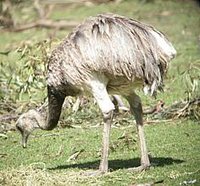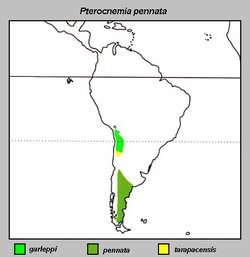Rhea (bird)
|
|
| Rheas Conservation status: Vulnerable | ||||||||||||
|---|---|---|---|---|---|---|---|---|---|---|---|---|
 | ||||||||||||
| Scientific classification | ||||||||||||
| ||||||||||||
| Species | ||||||||||||
|
Rhea americana |
Rheas, also known as ˝and˙ (pronounced nyandu) are large flightless birds native to South America. The name was given in 1752 by Paul Mohring; his reason for choosing this name, from classical mythology, is not known.
Rheas are polygamous, with males courting between two and twelve females. After mating, the male builds a nest, in which each female lays her eggs. The male incubates from ten to sixty eggs; the chicks hatch within 36 hours of each other. The females, meanwhile, may move on and mate with other males. While caring for the young, the males will charge at anyone — including humans and female rheas — who approaches the chicks.
Rheas are omnivorous, preferring broad-leafed plants, but also eating seeds, roots, fruit, insects, and small vertebrates.
American Rhea
Rhea_americana_Distribuzione.jpg
Rhea americanus (also called the Gray or Common Rhea) is not only the largest species of rhea but the largest American bird, with adults averaging 30 kilograms (66 lb).
Farmers sometimes consider them pests, because they will eat almost any crop plant. Because of this habit, farmers sometimes kill the birds. This, along with egg gathering and habitat loss, has led to a sharp population decline; the species is listed as being of "special concern." They do not eat most crop plants, but they will eat brassicas (cabbage, and baby chard and bok choi) if very hungry soybean leaves. Rheas disdain grasses.
American Rheas live in grassland, savanna, scrub forest, chaparral, and even desert, but prefer areas with at least some tall vegetation. During breeding season (which ranges from August to January in South America, April to August in North America), they stay near water.
Male rheas are very territorial during breeding season. The infant chicks are highly intolerant of toxins, having high mortality in typical farming situations. Baby chicks under optimum conditions will grow to four feet tall by their fifth month.
Rheas have an incredible immune system that allows injured birds to heal rapidly with little intervention. This is reflected in the commercial uses of the animal. The fat of the birds is used as an anti-inflammatory salve. Use of the meat as an energy supplement is patented in the U.S. and Canada by an American woman who has spent 12 years working to reduce chick mortality and provide a commercial basis for the species, trying to ensure its long-term survival.
The American Rhea is a threatened species as listed in CITES.
Darwin's Rhea
Rhea pennatus (Darwin's Rhea, syn. R. darwini) is 90 to 100 centimeters (3 ft to 3 ft 4 in) tall, and has larger wings than other ratites, enabling it to run particularly well. They can reach speeds of 60 km/hour, enabling them to outrun predators. The strong claws at the end of each wing are effective weapons.
The males of this species become aggressive once they are incubating eggs. The females thus lay the later eggs near the nest, rather than in it. Most of the eggs are moved into the nest by the male, but some remain outside, where they rot and attract flies. The male, and later the chicks, eat these flies.
Outside the breeding season, Darwin's rheas are quite sociable: they live in groups of from 5 to 30 birds, of both sexes and a variety of ages.
Darwin's Rhea lives in areas of open scrub in the grasslands of Patagonia and on the Andean plateau. It is classified as endangered throughout its range.
The "Lesser Rhea" (Pterocnemia pennata, formerly R. macrorhyncha) appears to be a synonym for R. darwini.
See also
de:Nandus es:Đand˙ fr:Nandou nl:Rheiformes it:Rheidae pt:Ema

